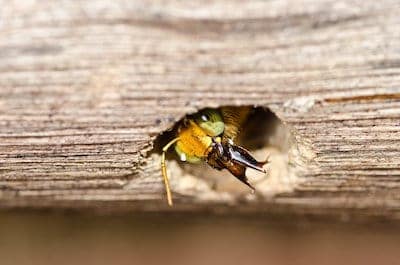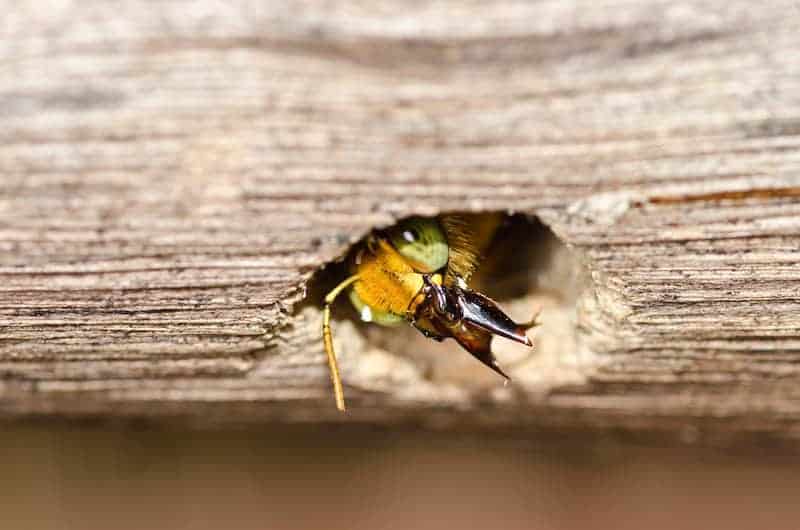Natural Ways to Get Rid of Carpenter Bees
Carpenter bees are one of the most common causes of phone calls to pest control companies. They can be a major nuisance, but they don’t pose any serious health risk and there is no need to panic if you find these bugs in your home.
So, how do you get rid of carpenter bees naturally? The best natural way to get rid of carpenter bees is to remove the following items from your home:
- Pine needles and other woody mulches.
- Any damaged or rotten wood that is in direct contact with ground level for a prolonged period of time. This includes plywood, poorly sealed window sills, etc.
The best way to get rid of carpenter bees naturally is to be aware of what attracts them to your property and take steps before they become an issue!
The more you know about these helpful insects, the better equipped you’ll be at fighting them off when necessary! It’s also important not only to understand how these beneficial bugs work but why they cause problems as well so we can properly learn ways on how to get rid of carpenter bees naturally.
Keep reading for all the information you need about carpenter bees: what they are, how to get rid of them naturally, where they live, and more!
What Are Carpenter Bees?
Carpenter bees are a type of solitary bee. They’re about three-quarters of an inch long and have black abdomens with stripes running from their heads to the tip of their abdomen, giving them a striped appearance. The carpenter bee is sometimes called the wood-borer bee.
The carpenter bee is a known pollinator and is considered helpful because they are considered to be secondary consumers of the ecosystem.
Where Do Carpenter Bees Live?
 Carpenter bees have been found in urban areas all over the world. Because of this, it is important to learn how to get rid of them naturally before any issues arise.
Carpenter bees have been found in urban areas all over the world. Because of this, it is important to learn how to get rid of them naturally before any issues arise.
They thrive on seeking out rotting or damaged wood. Items like fence posts, decks, and window sills where they will bore into their surface for nesting purposes.
This can lead to significant damage that requires costly repair jobs!
There has also been an association between long-term contact with fresh pine needles and other woody mulches as well as exposure to some types of pesticides that have led many people to think that the carpenter bee is a pest (and potentially dangerous) that needs to be exterminated.
It’s important not only to understand how these beneficial bugs work but why they cause problems as well so we can properly learn ways on how to get rid of carpenter bees naturally.
Life Cycle of Carpenter Bees
Much like other bees, the carpenter bee has four stages included in its life cycle: egg, larva, pupa, and adult. Carpenter bees progress through the life cycle and reach adulthood in around seven weeks. However, this timing varies depending on the environment in which they live.
In the northern states, carpenter bees have only one generation each year. However, in southern states, carpenter bees may have three or more generations each year. Because of the warmer climates, carpenter bees are more prevalent in the southern states as they have a longer season in which to mate, reproduce, and feed.
However, homeowners in northern states must remain vigilant as carpenter bees can cause serious structural damage in their short season of activity.
Differences Between Carpenter Bees And Other Bee Varieties
There are many different types of bees out there! The most important difference between these varieties is that carpenter bees don’t produce honey like other bee varieties do.
Instead, they chew on wood primarily for sap. This sap provides nutrition for larvae when they hatch inside tunnels created by adult female carpenter bees in dead or dying trees as well as wooden structures around your property. Items such as deck railings or window frames where moisture has accumulated over time due to contact with ground level are often a prime spot for carpenter bees.
Easy Solutions for Getting Rid of Carpenter Bees
There are many easy steps you can take to get rid of the carpenter bees that are threatening your home.
Remove Items That Attract Carpenter Bees
The first thing you should do if you notice carpenter bees around your home is to remove woody mulches or other items that provide a lot of shelter for these pests. Trim branches around your property so they don’t touch the ground and create unnecessary places where carpenter bees can become active.
Protect Your Home
Make sure you have screens on all of your windows to keep the carpenter bees out from indoors! Also, seal any cracks in window frames with caulk. If there’s structural damage, seek professional help right away. This will minimize the potential for carpenter bees entering your home.
Minimize Locations for Carpenter Bee to Nest
Install wire mesh over holes in decks or porches to deter carpenter bee nesting spots. Be aware if you’re renovating an old home – it may be more difficult than new construction because finding insulation inside walls could cause issues as well!
Clean Your Gutters
Lastly, make sure gutters are clear before spring arrives so they aren’t clogged up by leaves and debris. The debris and natural materials that will collect in clogged gutters provide a perfect place for eggs to be laid!
Are Carpenter Bees Dangerous?
Carpenter bees are not known for stinging people, but they do have mandibles that can bite if irritated.
It’s important to note that carpenter bees prefer soft and decaying wood as opposed to the hardwood used in most homes. Typically, carpenter bees do not pose a serious health risk unless you happen to be allergic!
However, just because you may not experience any symptoms of anaphylaxis when bitten by one of these pests does not mean there is no need to panic. How would YOU feel if you found out your home was infested with carpenter bees?
So, while carpenter bees may not necessarily be dangerous to the general public, they do pose a serious threat to the structural integrity of your home.
How to Handle a Carpenter Bee Infestation in Your Home
Carpenter bees can become a problem when they start nesting in your house or attacking you. If this is happening, be sure to call pest control professionals. A carpenter bee infestation could potentially hurt children and pets as well as damage your property.
If you own your home, this damage could cost several thousands of dollars. Even worse, if you are a renter and avoid handling the infestation in a timely manner, you may find yourself needing to hire a lawyer for neglecting the property!
In Conclusion
As with any type of pest, giving carpenter bees what they want will only encourage them to come back. Because of this, it is important to try the easy solutions we covered in this post before resorting to an exterminator service!
The more steps you take now, the less likely it’ll be that you need professional help later down the line. However, if you feel as if the infestation is serious, contacting a pest control professional is the best, and safest, course of action.
Much like other pests, carpenter bees are not likely something you will experience. However, for the unlucky homeowner that finds their home has fallen prey to these pests, prompt action is crucial to getting rid of carpenter bees once and for all in your home if you want to avoid costly home renovations.

